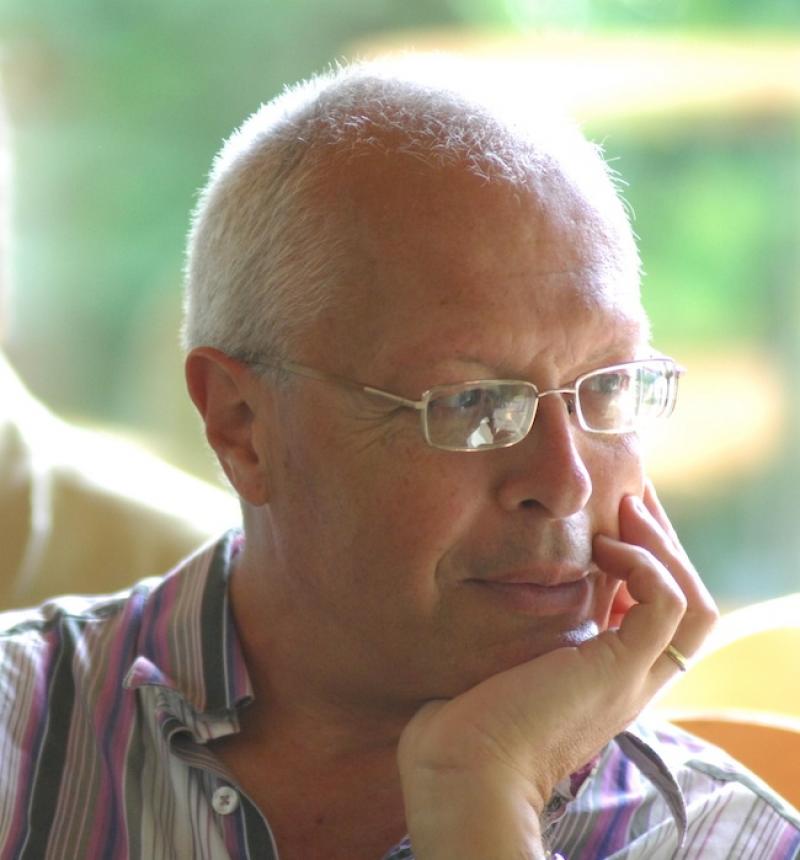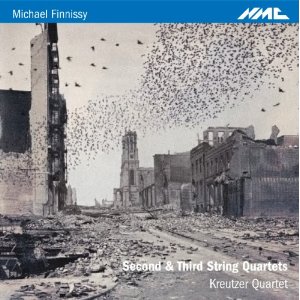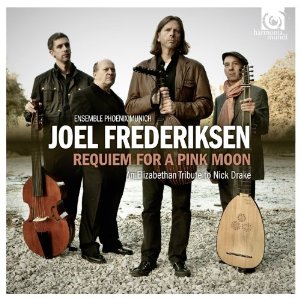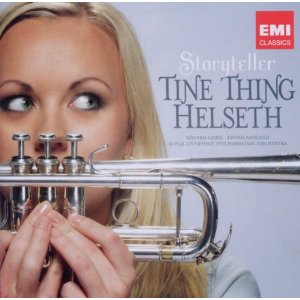Classical CDs Weekly: Michael Finnissy, Joel Frederiksen, Tine Thing Helseth | reviews, news & interviews
Classical CDs Weekly: Michael Finnissy, Joel Frederiksen, Tine Thing Helseth
Classical CDs Weekly: Michael Finnissy, Joel Frederiksen, Tine Thing Helseth
A German lutenist tackles Nick Drake, a Norwegian trumpet player sings without words and a British contemporary composer makes imaginative use of birdsong


Michael Finnissy, currently Professor of Composition at Southampton University, writes that his Second Quartet ”is based on a compact Haydn model”. The piece does pack a lot of event into 20 minutes, and there are sporadic flares of dry wit. Best is an extended passage near the close where cello and viola intone slowly moving consonant chords while the two violins screech about on top. It sounds as if we’re listening to two radically different compositions simultaneously. Or two duetting pairs recorded separately and then superimposed. You then read that there’s no score to this work, just four separate parts, which should “drift slightly apart, and definitely not seem calculatedly or rigidly aligned”. The quartet abruptly stops with a fading, consonant whimper. You scratch your head, slightly baffled, but intrigued. And then rush to listen to this 20-minute piece again.
The vast Third Quartet takes Bruckner as a structural model. Long, slow passages of music hint at conventional tonality, and the piece’s organisation is based on the letters spelling the name of the dedicatee. Finnissy also references Schoenberg’s Second Quartet, which famously introduces a soprano in the closing movement, by introducing taped birdsong 20 minutes in. Bird calls begin to colour the string lines, and the last few minutes consist purely of natural sounds. Its'a barely noticeable that 44 minutes have passed. Superb performances by the Kreutzer Quartet make both works, described by their composer as “rich and chewy”, far less forbidding than the cover photo of earthquake-ravaged San Franscisco would suggest.

American lutenist and bass Joel Frederiksen recalls the seismic impact of hearing Nick Drake’s recordings: “the union of the plaintive voice, the intricate guitar accompaniments, and the moving lyrics… spoke to me.” He taught himself to play several of Drake’s songs, occasionally revisiting them despite a flourishing career playing the lute. Frederiksen’s interest was reawakened years later by the use of the song Pink Moon in a car advert. He spent several years tinkering with the idea of performing Drake’s songs arranged for early instruments, interspersing them with works by Dowland and Campion as well as his own material. The sequence was topped and tailed with two brief sections of the Requiem Mass. The results add up to the unlikeliest of crossover projects. It’s tempting to skip straight to the Drake covers and marvel at how beautifully Frederiksen treats them. Drake’s mumbling delivery on record can make deciphering his obtuse lyrics a bit of a struggle, whereas Frederiksen’s crystal-clear diction is a joy. The discreet backings on lutes and theorbo are unfailingly sensitive.
You need to listen to this album in sequence. The sense of Drake’s belonging to a melancholy English song tradition is enhanced by juxtaposing his material with older composers, and the transitions between the numbers are brilliantly effective. It’s as if your ears have been abruptly syringed. Several of these songs take on a warmth, clarity and openness which is missing from Drake’s originals. And what could have been a maudlin wallow emerges as transcendent, affectionate and uplifting. Frederiksen sneaks in his own song, Ocean, afterTime has told me. A sweet tribute, and you find yourself wondering how it would sound in Drake’s own voice.

With the magnificent Alison Balsom already on their books, you wonder why EMI decided to sign up the young Norwegian trumpet player Tine Thing Helseth. Then you start listening to her new solo disc and accept that this is pretty sensational playing. Helseth’s sound is recognisably distinct from Balsom’s – slightly lighter, less imposing but not lacking in personality, and ideally suited to a collection of song transcriptions. “Although you lose the words, you have to play as if they were still there. To move the audience with a very simple tune is one of the hardest things to do.” Helseth is right, and she manages to hold your attention by carefully changing and colouring the sound she makes. You want more than a sequence of insubstantial lollipops, and the material is well chosen.
Mahler’s Wer hat dies Liedlein erdacht? can’t help recalling the lyrical trumpet and posthorn solos in the composer’s early symphonies. An aria from Korngold’s overheated Die tote stadt is indecently rousing. Big tunes demand a big sound, and Helseth really lets rip. Two of Canteloube’s Chants d’Auvergne are attractive, and my favourite among the orchestral transcriptions is Rachmaninov’s brief Zdes’ khorosho. The songs with piano don’t succeed as well; the trumpet slightly too forward in the mix. Brilliantly enjoyable though, as is a disc of music for Helseth’s 10-piece brass ensemble also released by EMI.
Tine Thing Helseth plays Rachmaninov
Explore topics
Share this article
The future of Arts Journalism
You can stop theartsdesk.com closing!
We urgently need financing to survive. Our fundraising drive has thus far raised £49,000 but we need to reach £100,000 or we will be forced to close. Please contribute here: https://gofund.me/c3f6033d
And if you can forward this information to anyone who might assist, we’d be grateful.

Subscribe to theartsdesk.com
Thank you for continuing to read our work on theartsdesk.com. For unlimited access to every article in its entirety, including our archive of more than 15,000 pieces, we're asking for £5 per month or £40 per year. We feel it's a very good deal, and hope you do too.
To take a subscription now simply click here.
And if you're looking for that extra gift for a friend or family member, why not treat them to a theartsdesk.com gift subscription?
more Classical music
 Bizet in 150th anniversary year: rich and rare French offerings from Palazzetto Bru Zane
Specialists in French romantic music unveil a treasure trove both live and on disc
Bizet in 150th anniversary year: rich and rare French offerings from Palazzetto Bru Zane
Specialists in French romantic music unveil a treasure trove both live and on disc
 Scottish Chamber Orchestra, Ibragimova, Queen’s Hall, Edinburgh review - rarities, novelties and drumrolls
A pity the SCO didn't pick a better showcase for a shining guest artist
Scottish Chamber Orchestra, Ibragimova, Queen’s Hall, Edinburgh review - rarities, novelties and drumrolls
A pity the SCO didn't pick a better showcase for a shining guest artist
 Kilsby, Parkes, Sinfonia of London, Wilson, Barbican review - string things zing and sing in expert hands
British masterpieces for strings plus other-worldly tenor and horn - and a muscular rarity
Kilsby, Parkes, Sinfonia of London, Wilson, Barbican review - string things zing and sing in expert hands
British masterpieces for strings plus other-worldly tenor and horn - and a muscular rarity
 From Historical to Hip-Hop, Classically Black Music Festival, Kings Place review - a cluster of impressive stars for the future
From quasi-Mozartian elegance to the gritty humour of a kitchen inspection
From Historical to Hip-Hop, Classically Black Music Festival, Kings Place review - a cluster of impressive stars for the future
From quasi-Mozartian elegance to the gritty humour of a kitchen inspection
 Shibe, LSO, Adès, Barbican review - gaudy and glorious new music alongside serene Sibelius
Adès’s passion makes persuasive case for the music he loves, both new and old
Shibe, LSO, Adès, Barbican review - gaudy and glorious new music alongside serene Sibelius
Adès’s passion makes persuasive case for the music he loves, both new and old
 Anja Mittermüller, Richard Fu, Wigmore Hall review - a glorious hall debut
The Austrian mezzo shines - at the age of 22
Anja Mittermüller, Richard Fu, Wigmore Hall review - a glorious hall debut
The Austrian mezzo shines - at the age of 22
 First Person: clarinettist Oliver Pashley on the new horizons of The Hermes Experiment's latest album
Compositions by members of this unusual quartet feature for the first time
First Person: clarinettist Oliver Pashley on the new horizons of The Hermes Experiment's latest album
Compositions by members of this unusual quartet feature for the first time
 Gesualdo Passione, Les Arts Florissants, Amala Dior Company, Barbican review - inspired collaboration excavates the music's humanity
At times it was like watching an anarchic religious procession
Gesualdo Passione, Les Arts Florissants, Amala Dior Company, Barbican review - inspired collaboration excavates the music's humanity
At times it was like watching an anarchic religious procession
 Classical CDs: Camels, concrete and cabaret
An influential American composer's 90th birthday box, plus British piano concertos and a father-and-son duo
Classical CDs: Camels, concrete and cabaret
An influential American composer's 90th birthday box, plus British piano concertos and a father-and-son duo
 Cockerham, Manchester Camerata, Sheen, Martin Harris Centre, Manchester review - re-enacting the dawn of modernism
Two UK premieres added to three miniatures from a seminal event of January 1914
Cockerham, Manchester Camerata, Sheen, Martin Harris Centre, Manchester review - re-enacting the dawn of modernism
Two UK premieres added to three miniatures from a seminal event of January 1914
 Kempf, Brno Philharmonic, Davies, Bridgewater Hall, Manchester review - European tradition meets American jazz
Bouncing Czechs enjoy their Gershwin and Brubeck alongside Janáček and Dvořák
Kempf, Brno Philharmonic, Davies, Bridgewater Hall, Manchester review - European tradition meets American jazz
Bouncing Czechs enjoy their Gershwin and Brubeck alongside Janáček and Dvořák
 Solomon, OAE, Butt, QEH review - daft Biblical whitewashing with great choruses
Even a top soprano and mezzo can’t make this Handel paean wholly convincing
Solomon, OAE, Butt, QEH review - daft Biblical whitewashing with great choruses
Even a top soprano and mezzo can’t make this Handel paean wholly convincing

Add comment